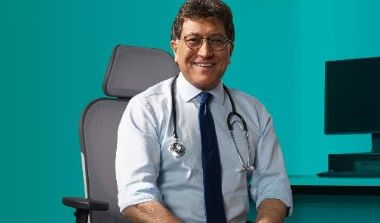Keyhole surgery to investigate, diagnose and treat joint problems, such as problems with the ankles, elbows, hips, knees, shoulders or wrists.
Why you might need it
An arthroscopy uses keyhole surgery to investigate the joints. This involves passing a thin, flexible, telescope-like tube with a camera and light on the end (arthroscope) into your joint via a small cut. An arthroscopy is often used to investigate and treat ankles, elbows, hips, knees, shoulders and wrists. Your doctor may recommend an arthroscopy if your joint is inflamed, injured or worn out.
As it is a keyhole procedure and uses small cuts, the recovery time is usually faster and less painful than with traditional, open surgery. Keyhole surgery also has a lower risk of infection and you can usually return home on the same day as your procedure or the next day.
Your doctor may recommend an arthroscopy if you have a persistent joint problem, such as pain, swelling or stiffness, and scans have not been able to identify the cause. An arthroscopy can help your doctor make a diagnosis and assess the extent of damage caused by a variety of conditions, such as a sports injury or osteoarthritis.
An arthroscopy can also be used to treat joint problems, such as draining excess fluid, removing loose bone or cartilage fragments and repairing torn cartilage. It can be used to treat inflamed joint linings, scarred joint tissue and a range of joint conditions, including anterior cruciate ligament (ACL) tears, arthritis, carpal tunnel syndrome, frozen shoulder and temporomandibular disorder.
Who will do it?
Before your treatment
If your doctor has recommended that you have an arthroscopy, they will arrange for you to attend a pre-admission clinic.
During this appointment, your healthcare team will ask you about your general health to ensure you’re ready for surgery. Make sure you tell them about any medications or supplements you’re taking — you may need to stop taking certain medications in the days or weeks before your surgery.
They will explain the benefits and risks of the procedure as well as how to prepare for it, such as what and when to eat and drink the night before and day of your surgery. In most cases, unless your doctor advises otherwise, you will be told not to eat or drink anything from the night before your surgery.
Your healthcare team will also tell you about how long your recovery will likely take and whether you will need rehabilitation exercises after your surgery.
You will have time to ask any questions and will then be asked to sign a consent form — this confirms that you are happy to go ahead with the procedure and understand the risks.
Preparing for your treatment
On the day of your arthroscopy, make sure you wear loose, comfortable clothing, so that you can easily get dressed after your procedure. If you’re having a knee arthroscopy, you may find it easier to wear loose-fitting shorts.
Just before your arthroscopy, you’ll be given a sponge and some soapy water to clean the skin over the joint that will be operated on.
Make sure that after your arthroscopy you have someone there to drive you home.
The procedure
An arthroscopy usually takes between 30 minutes to 2 hours, depending on what investigations or treatment is needed.
Anaesthesia
In most cases, an arthroscopy is performed under general anaesthetic but sometimes spinal anaesthetic or local anaesthetic is used. A doctor who specialises in anaesthesia (an anaesthetist) will talk to you about whether you can choose which type of anaesthesia you have and will advise you on which is most appropriate in your case.
If your arthroscopy is performed under local anaesthetic, you won’t feel any pain but may feel some mild tugging sensations during your procedure.
Getting ready for surgery
You’ll be placed in a suitable position (eg on your back or on your side) depending on which joint is being operated on. Your joint will be held still by placing your limbs in a positioning device. A tourniquet may also be tied above your joint to reduce blood flow and consequently blood loss and make it easier for your surgeon to see inside your joint. Next, the skin over your joint will be cleaned with an antibacterial fluid.
Your arthroscopy procedure
A small cut will be made into your joint through which the arthroscope will be passed. One or more extra cuts may be needed to pass small surgical instruments into your joint.
In some cases, your joint may be filled with a sterile fluid to expand it so your surgeon can more easily see what’s going on inside it. Video images from the arthroscope will be sent to a digital screen or eyepiece so your surgeon can examine and/or treat your joint.
If needed, your surgeon may remove tissue that is causing a problem or repair damaged tissue. If during your arthroscopy, your surgeon determines that you need traditional, open surgery to fix your joint problem, they may do this at the same time.
After your arthroscopy
The arthroscope and any surgical instruments will be removed and any excess fluid drained. The cuts will be closed using stitches or special tape and your wound will be covered with a sterile dressing. In most cases, you can go home on the same day as your procedure, if not, the next day.
Aftercare
The recovery time after an arthroscopy varies depending on which joint was operated on and what investigations or treatments were performed.
As arthroscopy is a type of keyhole surgery, recovery is faster than with open surgery and you may be able to return to work after one week if your job is not physically demanding. If your work is physically demanding, it may take up to two weeks before you can return.
It will take at least six weeks and in some cases, several months before you can perform more strenuous tasks, such as heavy lifting or sports. You can drive again once you’re no longer in any pain and can safely do an emergency stop — it can take several weeks or months to reach this point.
Your healthcare team will advise you on which activities and sports to avoid while you’re recovering.
Immediately after your arthroscopy
If your arthroscopy was performed under general anaesthetic, you’ll be taken to a recovery room as soon as your arthroscopy is complete where you will be monitored as the general anaesthesia wears off.
Once you are fully conscious you may experience some pain. Your nursing team can give you painkillers to relieve your pain.
Leaving hospital
In most cases, you can go home on the same day as your procedure, if not, the next day. Before you’re discharged, a physiotherapist may talk to you about rehabilitation exercises to do at home.
Depending on which joint was worked on during your arthroscopy, you may need to wear a sling or splint, or use crutches to support your joint during your recovery. You may also be given special compression bandages to improve blood flow through your joint and limbs while you recover.
It is recommended that you arrange for someone to pick you up from hospital after your procedure, particularly if you have had general anaesthetic as you may feel lightheaded. It can take up to 48 hours to recover from general anaesthesia and you may want someone to stay with you during this time.
Recovering at home
Your healthcare team will advise you on what to do to help your recovery. They may recommend raising your joint and applying ice packs periodically to reduce any swelling.
Make sure you follow any rehabilitation exercises provided by your physiotherapist and keep your dressings clean and dry — you can cover your dressings with a plastic bag when bathing or showering. If your dressings fall off or get wet, you will need to replace them with clean, sterile dressings.
Your wound should begin healing after one or two days. Your dressing can usually be removed after 5–10 days. If non-dissolvable stitches were used to close your wound, these will need to be removed after 1–2 weeks — this can usually be done by a nurse at your GP practice.
During your recovery, don’t drink alcohol and if needed, take painkillers as advised by your healthcare team.
A few weeks after your arthroscopy, you will need to attend a follow-up appointment to check on your recovery and discuss the results of your arthroscopy as well as whether any further treatment is needed.
When to contact your healthcare team
If you’re concerned that you have developed a complication after your arthroscopy, such as an infection, nerve damage or blood clot, call your GP or surgical team. Signs of a complication include:
- A fever
- Discharge from your wound that smells unpleasant or is white, yellow or brown in colour
- Numbness or tingling
- Severe or worsening pain
- Severe or worsening redness or swelling
Important to note
The treatment described on this page may be adapted to meet your individual needs, so it's important to follow your healthcare professional's advice and raise any questions that you may have with them.
Spire Alexandra Hospital,
Impton Lane
Walderslade
Chatham
ME5 9PG



